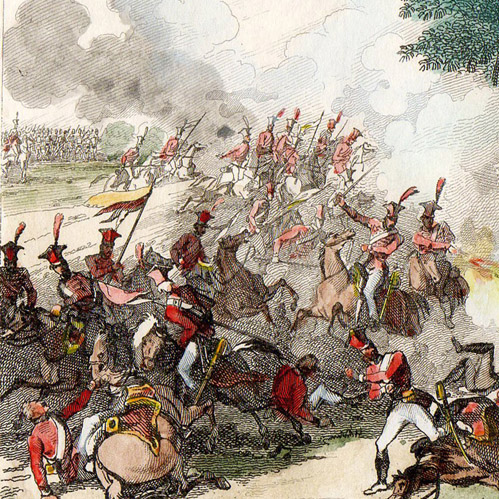
Decisive Austrian victory over the French, which ended the campaign on the Rhine during the War of the First Coalition. After initially withdrawing, Archduke Charles had defeated French general Jean-Baptiste Jourdan at Amberg and driven him west to Würzburg. The battle gradually extended northward until Charles massed his cavalry to destroy the French center. Jourdan withdrew across the Rhine, allowing Charles to turn south and force General Jean Moreau to retreat hastily from Bavaria.
After victory at Amberg, Charles drove Jourdan’s Army of the Sambre and Meuse toward the key crossroads at Würzburg. On 1 September, Charles pushed two divisions (under Feldmarschalleutnant Johann Freiherr von Hotze and Generalmajor Anton Graf Sztaray) toward the city. Jourdan had reached Schweinfurt, 40 kilometers to the northeast and, leaving General François Lefebvre’s division, marched to preempt the Austrians on 2 September. General Jacques-Philippe Bonnaud’s reserve cavalry and General Edouard François Simon’s infantry division were soon driving Hotze toward the city, but Sztaray secured the Repperndorf hills, east of the city, to cover the archduke’s advance. Jourdan arrived with General Jean Etienne Championnet’s division and General Dominique Klein’s cavalry, who evicted Sztaray from Kurnach village. General Paul Grenier’s division brought the French total to 30,000. Charles massed 31,000 infantry and 13,000 cavalry.
On 3 September, thick fog disguised the archduke’s advance. Sztaray and Hotze attacked Simon around Lengfeld at dawn, driving the French out of the Kurnach valley. Jourdan counterattacked around 10:00 A. M. to split Sztaray from Charles, whose troops were arriving. Championnet attacked Sztaray frontally, while Simon retook Lengfeld toward noon, and from the north, Bonnaud and Grenier attempted to outflank Sztaray’s right. Charles rushed Feldmarschalleutnant Paul Kray Freiherr von Krajova’s light cavalry division forward, and they moved north to face Bonnaud. Kray’s infantry followed, while Feldzeugmeister Ludwig Graf Wartensleben’s heavy cavalry forded the river and turned north. Around noon, Grenier’s advance was halted by Kray’s cavalry, and Championnet was making no progress against Sztaray. By 1:00 P. M. Kray’s infantry were engaging Grenier, and Wartensleben’s cavalry had reached Euerfeld. As the two armies formed up along a southwest to northeast alignment, Jourdan massed Bonnaud’s cavalry on Championnet’s left, allowing Klein’s light cavalry to attack Kray. Frantic orders were dispatched to Lefebvre to send reinforcements, but Kray’s cavalry had cut the road.
As Klein attacked, Generalmajor Johannes Fürst zu Liechtenstein’s light cavalry countercharged, only to be repulsed by Bonnaud, while Sztaray was joined by Austrian grenadiers at 3:00 P. M. Bonnaud counterattacked, but Charles halted him with some heavy cavalry, while others attacked Grenier’s right. As Kray drove Grenier northward, Austrian cavalry massed in the center and in a single charge swept Bonnaud away. Jourdan ordered a retreat to the northwest, pursued by the grenadiers and light infantry into the Gramschatzer Forest, near where Austrian cavalry broke four French squares. The French lost 6,000 troops, compared with an Austrian total of 1,469. It was Charles’s greatest victory and rewarded his daring campaign strategy.
References and further reading Blanning, T. C. W. 1996. The French Revolutionary Wars, 1787-1802. London: Arnold. Charles, Archduke. 1816. Grundsätze der Strategie erlautert durch die Darstellung des Feldzuges in Deutschland 1796 [Principles of Strategy Explained by a Description of the 1796 campaign in Germany].Vienna: Strauss. Hollins, David. 1996. “Decided by Cavalry: Würzburg 1796.” Age of Napoleon 20 (Spring): 12-17. Phipps, Ramsay Weston. 1980. The Armies of the First French Republic and the Rise of the Marshals of Napoleon I. Vol. 2, The Armées de la Moselle, du Rhin, de Sambre-et-Meuse, de Rhin-et-Moselle. London: Greenwood. (Orig. pub. 1926-1939.)
Order of battle
French Army
Army of Sambre-et-Meuse: General of Division Jean-Baptiste Jourdan
25,000 infantry, 5,000 cavalry, 11 artillery batteries
Division: General of Division François Joseph Lefebvre
Division: General of Division Paul Grenier
Division: General of Division Jean Étienne Championnet
Division: General of Division Jean-Baptiste Bernadotte
Cavalry Reserve: General of Division Jacques Philippe Bonnaud
Austrian Army
Army of the Lower Rhine: Feldmarschall Archduke Charles (30,000)
Division: Feldmarschall-Leutnant Friedrich Freiherr von Hotze
Mixed Brigade: General-Major Michael von Kienmayer
Infantry Brigade: General-Major Johann von Hiller
Cavalry Brigade: Oberst Anton Canisius
Division: Feldmarschall-Leutnant Anton Sztáray
Mixed Brigade: General-Major Prince Johann of Liechtenstein
Infantry Brigade: General-Major Eugen Montfrault
Bavarian Infantry Brigade: General-Major Bartels
Grenadier Brigade: General-Major Konrad Valentin von Kaim
Division: Feldmarschall-Leutnant Johann Sigismund Riesch
Cavalry Brigade: General-Major Prince Alexander of Württemberg
Cavalry Brigade: General-Major Joseph Spiegelberg
Division: Feldmarschall-Leutnant Pál Kray
Cavalry Brigade: General-Major Friedrich Hohenlohe-Ingelfingen
Cavalry Brigade: General-Major Karl Joseph Hadik von Futak
Infantry Brigade: General-Major Franz Sebottendorf
Infantry Brigade: General-Major Prince Friedrich of Orange
Infantry Brigade: Feldmarschall-Leutnant Joseph Staader
Reserve: Feldzeugmeister Wilhelm von Wartensleben
Grenadier Brigade: General-Major Johann Kollowrat
Grenadier Brigade: General-Major Joseph von Schellenberg
Grenadier Brigade: General-Major Ludwig von Vogelsang
Cavalry Brigade: General-Major Prince Franz Seraph of Rosenberg-Orsini
Cavalry Brigade: Feldmarschall-Leutnant Karl of Lorraine-Lambesc